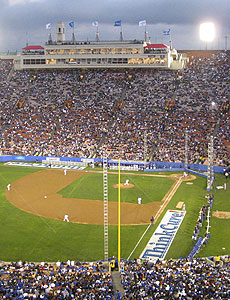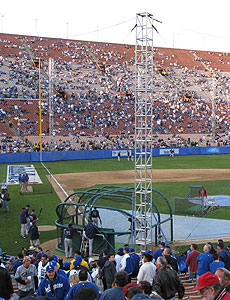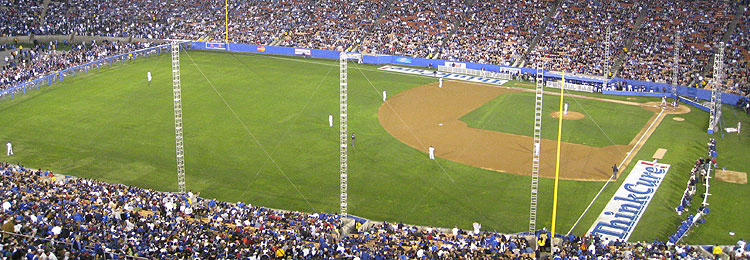
|

One hundred fifteen thousand three hundred. A number so large it needs to be spelled out. That was the paid attendance, not for a NASCAR race, but a baseball game, and an exhibition baseball game at that. Meaning what happened at the Los Angeles Memorial Coliseum on March 29, 2008 didnít count in the standings, just in the stands. The announced attendance Ė with an emphasis on announced Ė of 115,300 to watch the Red Sox play the Dodgers in their original West Coast home was one for the record books. Specially, the Guinness Book of World Records. The Coliseum gathering broke the previous record for largest crowd to bear witness to a baseball game. That record had stood since December 1, 1956, when 114,000 people watched an exhibition between the Australian national team and an American services team during that yearís Olympics in Melbourne. Fitting, then, that the attendance record would be broken in Los Angelesí Olympic venue, as the Coliseum hosted the 1932 and 1984 Olympic Games.
As for the accuracy of the record-breaking 115,300 reported and recorded, number of tickets sold equaled announced paid attendance. In reality, there were at least 10,000 empty seats scattered throughout the 92-row oval seating bowl and Iíd guesstimate there were 95,000 fans on the actual premises. For those of us who were there, it was a very memorable event. And make no mistake, this was more of an event than a ballgame. Ceremonies were held before the game and then interspersed during the nine inning affair, which was merely a spring training game but was treated as so much more. Among the memorable moments, Vin Scully was flattered to be feted in the pregame ceremonies, which began a half hour before the ceremonial first pitch was tossed by Wally Moon. Kareem Abdul-Jabbar threw out another first pitch an inning later, bouncing his toss towards home plate. Given another opportunity, Kareem sky hooked the ball into Russell Martinís mitt. The Olympic cauldron was lit after the fifth inning. As a tribute to Red Sox fans, Sweet Caroline was played during the middle of the eighth, just as it always is at Fenway Park. No modern ballpark is more well known for its quirkiness than Fenway, but the venerable Boston ballyard is no match for the idiosyncrasies of the Coliseum, which the Dodgers spent $500,000 to retrofit for the one night stand. The left field wall, which stood at 250 feet when baseball was played at the Coliseum from 1958-61, was just 201 feet from home plate. How short is that? "In the Little League World Series, left field runs 225 feet,Ē noted Bill Shaikin of the LA Times.
The bullpens were side by side in foul territory, the mounds nearly even with third base. The temporary backstop was placed about a dozen feet behind home plate, and a broken bat got stuck in the scaffolding that held the netting up. The most unusual reminder that this was indeed your grandfatherís ballpark was the nearly rectangular shape of the playing field, on which the very faded yard markers of USCís football field were visible. Because of the irregular shape, right field looked to be much further away than the 300í feet it was. The temporary fence erected in right field gave the makeshift playing field a Little League feel. The game itself was fairly uneventful, save for a 2-8 caught stealing in the fourth when Jacoby Ellsbury was gunned down at second by Martin with center fielder Andruw Jones covering the bag. The Dodgers used a five-man infield throughout the game, with their center fielder playing shallow in the outfield grass behind second base. Surprisingly, there were a mere four home runs. Kevin Cash, a career .167 hitter, belted the first one, sending the ball well beyond the left-field power alley situated 280 feet from home plate. Kevin Youkilis, James Loney and Blake DeWitt also went deep. Manny Ramirez, the best pull hitter long ball threat in either line-up, didnít play. As the game wore on, fans began to leave and the blue flags that ringed the stadiumís upper deck disappeared. Most were taken from the flag poles without drawing the ire of authorities, but one souvenir seeker was caught in the act on the video scoreboard prior to the ninth inning. ďPut the flag back,Ē was written over the live video feed. He didnít, and was carted off to jail when stadium security arrived on the scene. No doubt, the story of the night was the crowd. Numbers in baseball have gotten bigger over the years Ė contracts, ticket prices, home run totals Ė but the capacities of ballparks havenít. Mammoth multipurpose stadiums, such as 78,000-seat Municipal in Cleveland, were replaced by modern ballparks with only enough supply of seats to ensure their demand. The Dodgers followed that trend well before most teams, building Dodger Stadium six miles north of the Coliseum, which they abandoned after the 1961 season. That meant it was unlikely that the Major League single game attendance record of 93,103 would ever be broken. That was also for an exhibition game at the Coliseum, albeit a mid-season one, which took place on May 7, 1959 in honor of Roy Campanella, who had been paralyzed the year before in a car accident. Tickets for the game nearly a half-century later, which benefitted the Dodger's new Think Cure cancer charity, sold out less than an hour after being available for public consumption on February 2. But since two-thirds of the original 90,505 tickets were purchased by season-tickets holders prior to the public sale, the team decided to give another 25,000 fans a standing room only opportunity. Those tickets were snapped up quickly after they went on sale four weeks later. Regardless of whether fans sat or stood, prices were reasonable for an event of this magnitude - $15 and $25 for the seating bowl, $10 for those who stood where they could. That was a lot cheaper than the $25-$60 it cost to park a car near the Coliseum. The Dodgers provided free parking and a shuttle from their ballpark, but were overwhelmed with the response. When the gates at the Coliseum opened three hours before the game began, wait times back at Dodger Stadium for a shuttle approached two hours. I know because thatís when I showed up, along with pal and ballpark guru Joe Connor. Fortunately for us, we parked across from a couple from Palmdale who didnít feel like waiting in line. The good Samaritans in the yellow Ford Mustang offered to take us down to the Coliseum and dropped us off at the gates. After they decided not to pay the cost of a good meal to park, they gave us their tickets. Thanks Brian and Peggy, you made the experience much more enjoyable with your generosity. For those that did make it to the game Ė and there were quite a few who bailed when they saw the line for the shuttle Ė the experience was a once-in-a-lifetime thrill. Sure, concession stands ran out of pizza at one point during the game, but itís hard to prepare for an event only a few months after it was conceived. The gameís location wasnít approved until after Thanksgiving. A baseball diamond hadnít been used on Coliseum grounds since September 20, 1961, when Sandy Koufax pitched all 13 innings of a 3-2 victory over the Cubs. Just 12,068 fans showed up to bid the Coliseum adieu that day. Itís hard to imagine that nearly 10 times as many people would want to show up to see the one day resurrection, but the ticket prices ensured fans of all ages and social strata would show up and they did, collectively helping to raise more than $1 million for Think Cure. That will be the everlasting legacy of the event and Dodgers owner Frank McCourt thanked fans for their support with a speech he delivered in between innings. The game itself was an afterthought, as most exhibitions are. The Red Sox, who flew in from Japan to be a part of the occasion, were winners, 7-4. But the night belonged to the fans and the memories that were made. No, there werenít really 115,300 people at the game. Heck, even if there were that wouldnít have been close to the Coliseum attendance record (134,254 showed up in 1963 to hear evangelist Billy Graham). For those that were there, who will ever forget the players in the tent-like dugouts joining us in doing the wave? Okay, I actually missed that while standing in line for pizza that never materialized, but I saw it on TV while waiting. At least I didnít have to stand the whole game like the fans in the peristyle end of the stadium, who stood on the cement slab where bleachers normally reside for USC football games. The Trojans play a half-dozen or so home games a year, but baseball at the Coliseum doesnít come around so often. So I just had to be there, and a lot of people were. No matter the actual attendance, the truth is a crowd of this size will never be seen, or heard, at a baseball game again.
|

 For those wondering if the Dodgers could actually fit 115,300 with the confines of the Coliseum, the answer was no. Coliseum entrances were moved and fans inside the gates (but outside the ballpark) who watched the game on TV were counted.
For those wondering if the Dodgers could actually fit 115,300 with the confines of the Coliseum, the answer was no. Coliseum entrances were moved and fans inside the gates (but outside the ballpark) who watched the game on TV were counted.
 A 60í screen had to be cleared in left for a ball to be declared a home run. USC football coach Pete Carroll did it three times when he took batting practice at the Coliseum a week before the Major Leaguers did.
A 60í screen had to be cleared in left for a ball to be declared a home run. USC football coach Pete Carroll did it three times when he took batting practice at the Coliseum a week before the Major Leaguers did.

